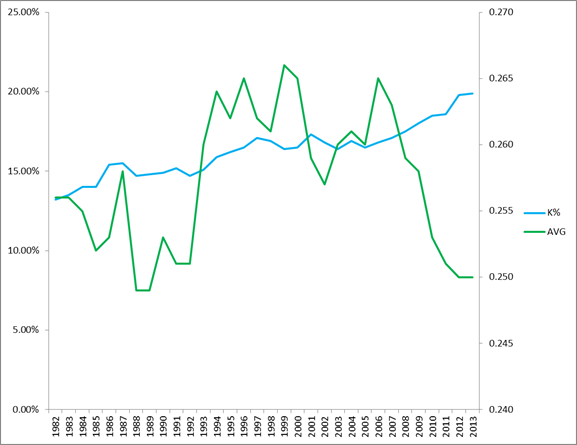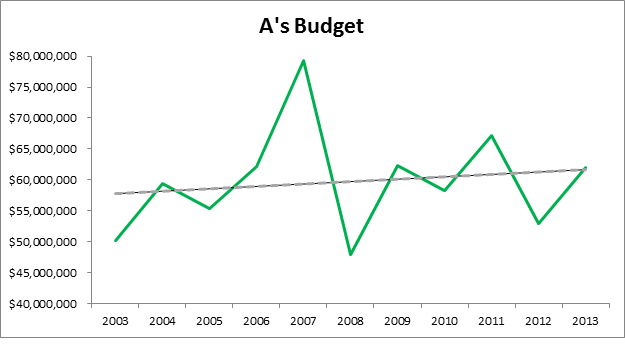By now, we fantasy aficionados all aware of we’re at historic levels in terms of strikeout rates. Since 2008, strikeout rates have increased year over year and 2013 was even higher (0.1 percent) than 2012. Therefore, it’s important to adjust the strikeout rate used a benchmark when evaluating starting pitchers for 2014. The graph below shows pitcher’s strikeout rates and batting average against since 1982.
 On draft day every fantasy owner should have targets for each category. In general, it takes roughly 90-92 points to win a 5×5 roto league with 12 teams with weekly lineups. Therefore, fantasy owners should strive to finish third and fourth in every category.
On draft day every fantasy owner should have targets for each category. In general, it takes roughly 90-92 points to win a 5×5 roto league with 12 teams with weekly lineups. Therefore, fantasy owners should strive to finish third and fourth in every category.
For strikeouts, last year 1,400 strikeouts was more or less were the requirement. A pitching staff (with nine pitchers starting) will throw roughly 1,494 innings, of which, 1,314 will come from starting pitchers and 180 innings from relievers. In terms of the strikeout ratios, 85-88 percent of the strikeouts will come from starting pitchers. If you take 1,400 and multiple it by 87 percent you get 1,218 strikeouts needed from starters and 182 from relievers.
Now that we have these two end points we can calculate what strikeout rate is needed from starting pitchers in order to achieve 1,218 strikeouts. On average a starting pitcher has 4.25 plate appearances per inning so if you multiply 4.25 by 1,314 you get 5,584.5; if you divide that number by 1,218 you get 21.81 percent. Therefore, starting pitchers need to have a strikeout rate of 21.81 percent in order to achieve 1,218 strikeouts.
Last year there were only 44 pitchers who pitched at or above the 21.8 percent threshold (with at least six games started). With strikeouts at such a premium, rostering extremely high strikeout pitchers such as Yu Darvish and Max Scherzer will provide extra roster flexibility and allow fantasy owners to win the strikeouts category.
Random tangent, suppose Darvish did not lose the four 1-0 games and finished the year with 16 wins instead of 13, rating Darvish as the number one fantasy pitcher would have more support. That said, the more I’m thinking about it, the more I like Darvish as my number one pitcher next year.
In order to finish third in saves requires approximately 99-103 saves, which is only 33 saves per pitcher (supposing you draft three closers). Using the same method outlined above, the strikeout rate needed from closers is 24.5 percent. The math calculation is as follows: 180 innings multiplied by 4.13 (plate appearances they face per inning) equals 743.4; 182 strikeouts divided by 743.4 equals 24.5 percent. Most closers fulfill this strikeout rate so during the evaluation period fantasy owners should focus on the pitchers job security and overall effectiveness.
It’s also possible to fulfill this requirement by drafting closers near the end of your drafts. For example, last year I drafted Grant Balfour, Jason Grilli and Casey Janseen in the 16th and 17th round and their final totals were 105 saves and 196 strikeouts, both of which are above the thresholds needed for this category. In 2014 let the Craig Kimbrell, Aroldis Chapman and Kenley Jansen proponents use an early 5th-7th round pick on them and you can wait on saves.




